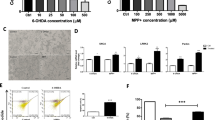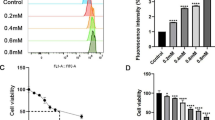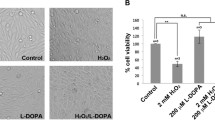Abstract
Accumulating evidence suggests that oxidative stress plays a pivotal role in dopaminergic neurodegeneration. However, the kinds of proteins involved in the response to oxidative stress remain unclear. In the present study, SH-SY5Y cells were treated with neurotoxin 1-methyl-4-phenyl-pyridinium ion (MPP+) to induce apoptotic neuronal injury. 2D-DIGE followed by MALDI-TOF-MS was used to determine the changing protein levels. Proteomics analysis revealed that 22 proteins were differentially altered in MPP+-treated SH-SY5Y cells, of which 7 were up-regulated proteins and 15 were down-regulated proteins, respectively. Three protein spots were unambiguously identified as sorcin, annexin V, and ribosomal protein P0. The three proteins showed a significant increase in level, suggesting a role in MPP+-induced apoptosis. The functional roles of these three proteins collectively indicate that multiple mechanisms are pertinent in the underlying pathogenesis of Parkinson’s disease (PD), such as apoptosis, calcium homeostasis, and DNA insults.




Similar content being viewed by others
References
Selvaraj S, Watt JA, Singh BB (2009) TRPC1 inhibits apoptotic cell degeneration induced by dopaminergic neurotoxin MPTP/MPP(+). Cell Calcium 46:209–218
Gandhi S, Wood NW (2005) Molecular pathogenesis of Parkinson’s disease. Hum Mol Genet 14:2749–2755
Lin MT, Beal MF (2006) Mitochondrial dysfunction and oxidative stress in neurodegenerative diseases. Nature 443:787–795
Dauer W, Przedborski S (2003) Parkinson’s disease: mechanisms and models. Neuron 39:889–909
Langston JW, Ballard PA Jr (1983) Parkinson’s disease in a chemist working with 1-methyl-4-phenyl-1, 2, 5, 6-tetrahydropyridine. N Engl J Med 309:310
Di Benedetto M, Cavina C, D’Addario C, Leoni G, Candeletti S, Cox BM et al (2009) Alterations of N/OFQ and NOP receptor gene expression in the substantia nigra and caudate putamen of MPP+ and 6-OHDA lesioned rats. Neuropharmacology 56:761–767
Colapinto M, Mila S, Giraudo S, Stefanazzi P, Molteni M, Rossetti C et al (2006) alpha-Synuclein protects SH-SY5Y cells from dopamine toxicity. Biochem Biophys Res Commun 349:1294–1300
Hanash S (2003) Disease proteomics. Nature 422:226–232
Palacino JJ, Sagi D, Goldberg MS, Krauss S, Motz C, Wacker M et al (2004) Mitochondrial dysfunction and oxidative damage in parkin-deficient mice. J Biol Chem 279:18614–18622
Zhang L, Chang M, Li H, Hou S, Zhang Y, Hu Y et al (2007) Proteomic changes of PC12 cells treated with proteasomal inhibitor PSI. Brain Res 1153:196–203
Lee do Y, Lee KS, Lee HJ, Noh YH, Kim do H, Lee JY et al (2008) Kynurenic acid attenuates MPP(+)-induced dopaminergic neuronal cell death via a Bax-mediated mitochondrial pathway. Eur J Cell Biol 87:389–397
Jin J, Hulette C, Wang Y, Zhang T, Pan C, Wadhwa R, Zhang J (2006) Proteomic identification of a stress protein, mortalin/mthsp70/GRP75: relevance to Parkinson disease. Mol Cell Proteomics 5:1193–1204
Werner CJ, Heyny-von Haussen R, Mall G, Wolf S (2008) Proteome analysis of human substantia nigra in Parkinson’s disease. Proteome Sci 6:8
Matsumoto T, Hisamatsu Y, Ohkusa T, Inoue N, Sato T, Suzuki S et al (2005) Sorcin interacts with sarcoplasmic reticulum Ca(2+)-ATPase and modulates excitation-contraction coupling in the heart. Basic Res Cardiol 100:250–262
Fowler MR, Colotti G, Chiancone E, Higuchi Y, Seidler T, Smith GL (2009) Complex modulation of L-type Ca(2+) current inactivation by sorcin in isolated rabbit cardiomyocytes. Pflugers Arch 457:1049–1060
Qi J, Liu N, Zhou Y, Tan Y, Cheng Y, Yang C et al (2006) Overexpression of sorcin in multidrug resistant human leukemia cells and its role in regulating cell apoptosis. Biochem Biophys Res Commun 349:303–309
Kawakami M, Nakamura T, Okamura N, Komoto C, Markova S, Kobayashi H et al (2007) Knock-down of sorcin induces up-regulation of MDR1 in HeLa cells. Biol Pharm Bull 30:1065–1073
Diaz-Blanco E, Bruns I, Neumann F, Fischer JC, Graef T, Rosskopf M et al (2007) Molecular signature of CD34(+) hematopoietic stem and progenitor cells of patients with CML in chronic phase. Leukemia 21:494–504
Terkawi MA, Jia H, Zhou J, Lee EG, Igarashi I, Fujisaki K et al (2007) Babesia gibsoni ribosomal phosphoprotein P0 induces cross-protective immunity against B. microti infection in mice. Vaccine 25:2027–2035
Mangano EN, Hayley S (2009) Inflammatory priming of the substantia nigra influences the impact of later paraquat exposure: neuroimmune sensitization of neurodegeneration. Neurobiol Aging 30:1361–1378
Yuan X, Kuramitsu Y, Furumoto H, Zhang X, Hayashi E, Fujimoto M et al (2007) Nuclear protein profiling of Jurkat cells during heat stress-induced apoptosis by 2-DE and MS/MS. Electrophoresis 28:2018–2026
Monge M, Vilaseca M, Soto-Cerrato V, Montaner B, Giralt E, Perez-Tomas R (2007) Proteomic analysis of prodigiosin-induced apoptosis in a breast cancer mitoxantrone-resistant (MCF-7 MR) cell line. Investig New Drugs 25:21–29
Nishida J, Shiratsuchi A, Nadano D, Sato TA, Nakanishi Y (2002) Structural change of ribosomes during apoptosis: degradation and externalization of ribosomal proteins in doxorubicin-treated Jurkat cells. J Biochem 131:485–493
Chetsawang B, Kooncumchoo P, Govitrapong P, Ebadi M (2008) 1-Methyl-4-phenyl-pyridinium ion-induced oxidative stress, c-Jun phosphorylation and DNA fragmentation factor-45 cleavage in SK-N-SH cells are averted by selegiline. Neurochem Int 53:283–288
Vermes I, Steur EN, Reutelingsperger C, Haanen C (1999) Decreased concentration of annexin V in parkinsonian cerebrospinal fluid: speculation on the underlying cause. Mov Disord 14:1008–1010
Acknowledgments
This work was supported by a grant from the Distinguished Professor Foundation of Jilin University to Dr. Linsen Hu (450011011204).
Author information
Authors and Affiliations
Corresponding author
Rights and permissions
About this article
Cite this article
Xie, H., Chang, M., Hu, X. et al. Proteomics analysis of MPP+-induced apoptosis in SH-SY5Y cells. Neurol Sci 32, 221–228 (2011). https://doi.org/10.1007/s10072-010-0340-3
Received:
Accepted:
Published:
Issue Date:
DOI: https://doi.org/10.1007/s10072-010-0340-3




